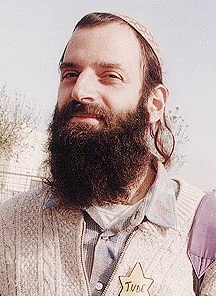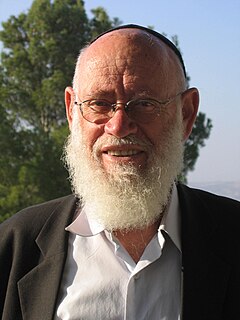
Baruch Kopel Goldstein was an American-Israeli physician, religious extremist, and mass murderer who perpetrated the 1994 Cave of the Patriarchs massacre in Hebron, killing 29 and wounding 125 Palestinian Muslim worshippers. He was beaten to death by survivors of the massacre.
Hilltop, outpost or lot 26, was an illegal outpost, consisting of a mobile home, founded by Netanel Ozeri outside Hebron in the West Bank. It lay approximately 100 metres (330 ft) from the Kiryat Arba settlement, in the Beqa'a valley. At the time of its destruction. Despite court orders, he kept expanding his outpost, refused to bullet-proof the caravan, fence the area he claimed in, or accept protection from the IDF.

Kiryat Arba or Qiryat Arba, lit. "Town of the Four," is an urban Israeli settlement on the outskirts of Hebron, in the Judean Mountains region of the West Bank. Founded in 1968, in 2018 it had a population of 7,323.

Moshe Levinger was an Israeli Religious Zionist activist and an Orthodox Rabbi who, since 1967, had been a leading figure in the movement to settle Jews in the territories occupied by Israel during the 1967 Six-Day War. He is especially known for leading Jewish settlement in Hebron in 1968, and for being one of the principals of the now defunct settler movement Gush Emunim, founded in 1974, among whose ranks he assumed legendary status. Levinger was reportedly involved in violent acts against Palestinians.
The Jewish Underground, or in abbreviated form, simply makhteret, was a radical right-wing organization considered terrorist by Israel, formed by prominent members of the Israeli political movement Gush Emunim that existed from 1979 to 1984. Two issues catalyzed the establishment of the underground: One was the signing of the Camp David Accords, which led to the Egypt–Israel Peace Treaty in 1979, and which the movement, opposed to the peace process, wished to block, viewing it as the first step in the establishment of a Palestinian state in what Jewish settlers call "Judea and Samaria". A second element was the settlement project, which, in bringing two distinct ethnic communities into closer proximity, led to an uptick in hostilities that brought about a growing emphasis on the existential threat in both communities. The Jewish underground developed two operational objectives: One consisted of a plot to blow up the Dome of the Rock, while the other branch concentrated on both avenging acts of Palestinian violence against settlers and of establishing a punitive deterrence. Some understood the terrorist acts as a means of inducing Palestinians to flee their homeland, and parallels are made with it to the Terror Against Terror movement, which had a similar aim. Robert Friedman stated that the Makhteret was "the most violent anti-Arab terrorist organization since the birth of Israel".
David Wilder is a leader of Israeli settlers and the spokesman for The Committee of The Jewish Community of Hebron.

Karmei Tzur, or Carmei Tzur is an Israeli settlement organized as a community settlement in the West Bank located north of Hebron in the Judean hills between the Palestinian towns Beit Ummar and Halhul. The National Religious community falls under the jurisdiction of Gush Etzion Regional Council. Under the terms of the Oslo Accords of 1993 between Israel and the Palestine Liberation Organization, Karmei Tzur was designated Area "C" under full Israeli civil and security control. In 2018 it had a population of 1,021.

Rabbi Dov Lior is an Israeli Orthodox rabbi, who served as the Chief Rabbi of Hebron and Kiryat Arba in the southern West Bank until late 2014. He is also the rosh yeshiva of the Kiryat Arba Hesder Yeshiva, and also heads the "Council of Rabbis of Judea and Samaria".

Beit HaShalom, or the Rajabi House, also known as Beit HaMeriva, is a four-story apartment building located in the H-2 Area of Hebron.

Beit Hagai, also Hagai, is an Israeli settlement organized as a community settlement located in the southern Hebron hills in the West Bank. The settlement population was 460 in 2004, according to a classified government document published by the Haaretz newspaper, and lies within the municipal jurisdiction of the Har Hebron Regional Council. The religious Jewish community's name, Haggai, is an acronym of the given names Hanan Krauthammer, Gershon Klein, and Yaakov Zimmerman, three Nir Yeshiva students murdered in the 1980 Hebron terrorist attack. The community rabbi for Beit Hagai is Rabbi Moshe Eliezer Rabinovich (HaLevy). In 2018 it had a population of 635. The international community considers Israeli settlements in the West Bank illegal under international law, but the Israeli government disputes this.
The Israeli–Palestinian conflict in Hebron refers to an ongoing conflict between Palestinians and Jewish settlers in the West Bank city of Hebron in the context of the Israeli–Palestinian conflict. Hebron has a Palestinian majority, consisting of an estimated 208,750 citizens (2015) and a small Jewish minority, variously numbered between 500 and 800. The H1 sector of Hebron, home to around 170,000 Palestinians, is governed by the Palestinian Authority. H2, which was inhabited by around 30,000 Palestinians is under Israeli military control with an entire brigade in place to protect some 800 Jewish residents living in the old Jewish quarter. As of 2015, Israel has declared that a number of special areas of Old City of Hebron constitute a closed military zone. Palestinians shops have been forced to close; despite protests Palestinian women are reportedly frisked by men, and residents, who are subjected every day to repeated body searches, must register to obtain special permits to navigate through the 18 military checkpoints Israel has set up in the city center.

Eliezer Waldman is an Israeli Orthodox rabbi and former politician, who served as a member of the Knesset for Tehiya between 1984 and 1990. Rabbi Waldman is the co-founder and President of Yeshivat Nir Kiryat Arba.

The August 2010 West Bank shooting attack was an attack near the Israeli town of Kiryat Arba in Judea and Samaria, carried out by Hamas militants. Four Israeli settlers were killed after gunmen attacked their vehicle. The four victims, including a pregnant woman, were civilians from the West Bank settlements of Beit Hagai and Efrat. It was the deadliest Palestinian attack on Israelis in over two years.
The 2002 Hebron ambush took place in the Wadi an-Nasara neighborhood in Hebron in the West Bank on 15 November 2002. Israeli forces were subjected to a double attack by fighters from the Palestinian Islamic Jihad. The battle was referred to in Israel as "The attack in the worshipers route",Hebrew: הפיגוע בציר המתפללים. The place where the attack took place became known as the "Alley of Death" both in Hebrew and Arabic. The ambush was initially dubbed as the "Sabbath massacre" by official Israeli spokespersons.

Worshippers Way or Prayers Road in Hebron, West Bank is a road linking the Israeli settlement of Kiryat Arba with the Cave of the Patriarchs and with the Jewish settlements in Hebron. The road is used by Israelis and tourists who visit the Cave and the Old City of Hebron. Palestinians are denied vehicular use of the road. The road was expanded after an ambush near Kiryat Arba that took place in November 2002. The expansion required that adjacent Palestinian land be expropriated, which resulted in a legal battle. A number of buildings of architectural and historical value, dating back to the Mamluk-Ottoman period, were also expropriated and destroyed.

An increase of violence occurred in the Israeli–Palestinian conflict starting early September 2015 and lasting into the first half of 2016, known as the "Intifada of the Individuals" by Israelis or the "Knife Intifada" or "Stabbing Intifada" by international media because of the preponderance of stabbing attacks, or "Habba" by Palestinians
On 30 June 2016, a 17-year-old Palestinian male broke into a home in the Israeli settlement of Kiryat Arba and stabbed to death Hallel Yaffa Ariel, a thirteen year old dual Israeli and American citizen, in her bedroom. The assailant was then fatally shot by security guards. Israeli Prime Minister Benjamin Netanyahu blamed "incitement-driven terrorists" while the U.S. State Department condemned the "outrageous terrorist attack".
Tayseer Abu Sneineh is a Palestinian Arab politician, a member of the Fatah party, and Mayor of Hebron, in the West Bank. He was convicted by Israel for taking part in the 1980 Hebron terrorist attack. He was elected Mayor of Hebron on 14 May 2017.










